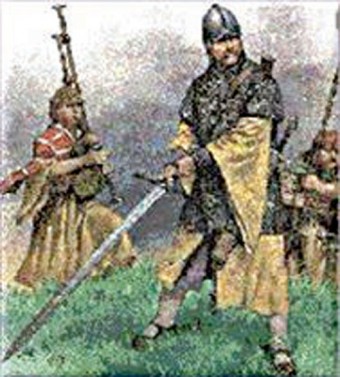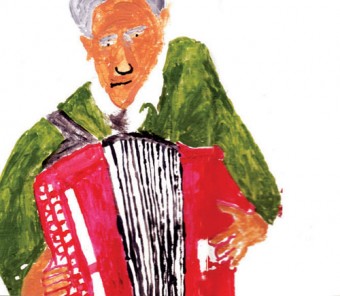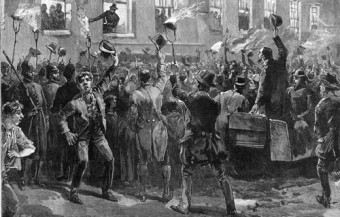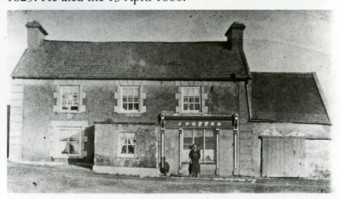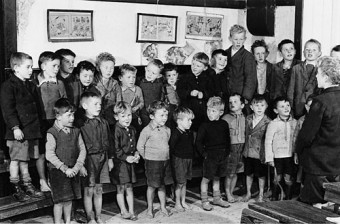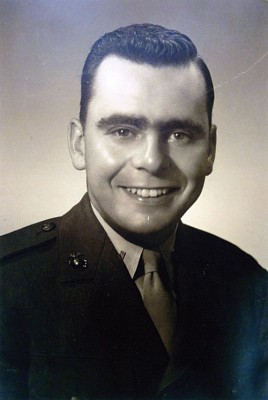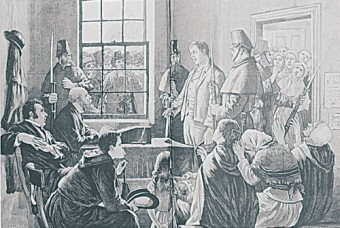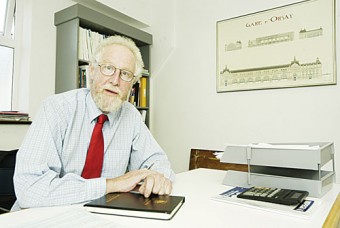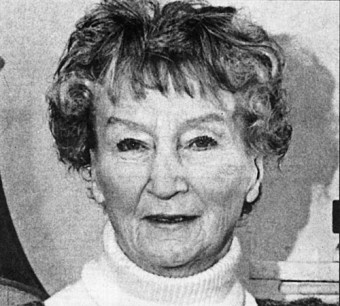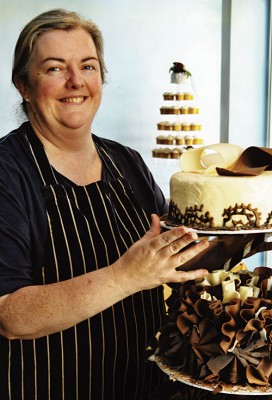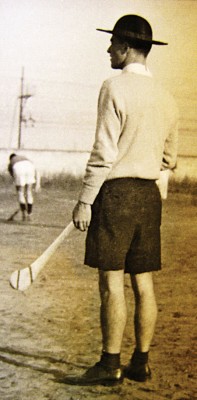Remembered love stories still ring true
Thu, Jun 24, 2010
O, hurry, where by water, among the trees,
The delicate-stepping stag and his lady sigh,
A landscape treasure on our doorstep
Thu, Apr 29, 2010
On several occasions I have purposely let myself get lost along the narrow roads of the Sliabh Aughty (Echtge*) uplands which extend over some 250 square miles over the southeast Galway and west Clare borders. It’s a territory way off the tourist trail. On either side of the road hedgerows are positive gardens of wild flowers in June. In August they collapse drunkenly along its edge.
Read more ...A child remembers Easter in Russia
Thu, Apr 01, 2010
The busy city of Harbin is the 10th largest city in China, and regularly features on our TV screens for its famous winter ice sculptures. In the 1920s, Harbin, practically on the borders of Russia, was a refuge for thousands of émigrés, fleeing the Bolshevik revolution and the blood bath that followed. The Russians, many of them wealthy, brought style and glamour to this once far flung post on the Trans-Siberian railway. Among those seeking refuge was a 74-years- old Galway/Russian woman Kathleen ffrench, who was not only the chatelaine of Monivea Castle and its 10,000 acre estate in Co Galway, but who also had inherited vast estates on the Volga from her Russian grandparents.
The ffrenchs (Ffrench), whose ancestor came to Ireland in the company of the Anglo-Norman nobleman Strongbow in the 12th century, was one of the 14 Tribes of Galway. Kathleen’s father Robert, whom she adored, served in the British diplomatic service, and met his young wife Sophie Alexandrovna de Kindiakov while working in St Petersburg. Although Robert was in his thirties and Sophie was just 18, and from a totally different culture, it was considered a brilliant match. Robert would inherit Monivea; while Sophie’s family were known from the 16th century as great landowners, breeders of fine horses, who harvested enormous acres of wheat and vines south of Simbirsk on both sides of the river around Kazan, about 600 kilometres southeast of Moscow.
Read more ...Running barefoot to their dreams...
Thu, Mar 18, 2010
Sometime in the 1880s my grandfather, Philip O’Gorman, left his home town of Littleton (An Baile Beag), north Tipperary, and walked into Galway. He must have been very well educated because his first job was reading the Dublin newspapers in two pubs in High Street. The Dublin papers arrived on the afternoon train. Then, surprisingly, he got a good job as an assistant librarian in the university. Surprisingly, because at the time it was a predominantly a Protestant institution. From there, he rented a small shop in High Street, established the Galway Printing Company, and cycled around Connemara getting orders for small printing jobs. These were later dispatched from the Claddagh quays to be delivered or collected from the small harbours all along the coast.
Read more ...A charming American who hid his battle secrets
Thu, Feb 25, 2010
I know it’s only a rumour, but nevertheless profoundly believed, that male medical students have an easy time with the girls. Many women appear to be under the impression that a doctor would make a ‘lovely husband’, and exert their wiles to make them believe they would make a perfect doctor’s wife.
Read more ...The Maamtrasna Murders, August 17 1882
Thu, Jan 28, 2010
Early on Friday August 18 1882, John Collins, a tenant farmer, having heard disturbances during the night coming from his neighbours’ house, the Joyces, went to check if all was well. He must have feared the worst because he brought with him two neighbours, Mary and Margaret O’Brien. They discovered an appalling sight. Even today, when our senses have been hardened by so many atrocities, it was a scene of savage murder that cried to heaven. No mercy was shown to this unfortunate family.
Read more ...Saving old buildings with new ideas
Thu, Jan 21, 2010
When it comes to planning applications in Galway, whether it is for a new building, or the renovation of an old building, modernisation or improvement, there are two strands of thought that can affect the decision from the local authority. I may not have all the technical jargon, but I understand that one side of the argument insists that pretty well every building that is a few generations old should be preserved. Any additional building must use the same or similar materials so that the addition appears to be a seamless add on.
Read more ...Paying roads repair money by kilometre is fairest
Thu, Jan 21, 2010
Now that the ice has melted and the snows have disappeared, people are really appreciating the opportunity to get out of the house and travel in a manner that was denied them during the cold snap.
However, this now represents a new danger as the ice and cold have left our roads network in the terrible shape. Road surfaces have been ravaged by the ice and grit, and at a time when the country is in the throes of economic misery, our already inadequate network has gone backwards and needs major refurbishment immediately.
Read more ...The Tulip of Tuam and other flowers
Thu, Jan 14, 2010
Many years ago I found the courage to ask the late Lady Molly Cusack -Smith whether she had posed nude for the famous artist Augustus John during his many sorties into Galway and the west. She looked at me very hard for some time. Then said in a very cross voice: “How dare you, HOW DARE YOU ask such a impertinent question!”
Read more ...The man who ran the ‘Corofin mile’
Thu, Jan 07, 2010
One of the most dramatic and legendary events in the history of Irish foxhunting took place with the Galway Blazers on December 19 1953 between Cregg Castle, Corandulla, and beyond the Clare river, near Anbally. This is great fox hunting terrain. It’s level going, open and free. When on a good scent the hounds will skim the walls and allow no time for man or beast to make mistakes if they want to stay close to them. December 19 1953 was a clear, frosty day, with similar temperatures to those we are enduring these past few weeks. The hounds were in full pursuit ‘skimming the long low walls the way the swallows do’. After a four mile chase they hit the river Clare about a mile short of the nearest bridge at Corofin village.
Read more ...Chasing the girls, and hunting the wren
Wed, Dec 23, 2009
Even though mistletoe is not native to Ireland it has long been associated with Christmas here. The tangled green plant, with its soft white berries, has been introduced in some Irish counties (grafted onto apple trees), and was being sold in basket fulls at the Galway market last December.
Read more ...Animals at war, virgins in Loughrea, poitín, and peace at the ‘Augi’...
Thu, Dec 17, 2009
World War 1 is the backdrop for the London box office success War Horse. It’s the story of bravery, loyalty and a mutual bond that grew between a young farm boy and his horse. But it is the highly imaginative and skilful way that the story is presented that has caught London’s imagination. The play is based on a book by Michael Morpurgo; and a recent acknowledgement by the public of the role animals have played in war, from the horse, the mule, the dog, the pigeon, even the humble glow worm used by sappers in No Man’s Land as they drew maps in the dark*. During the merciless, and relatively recent Battle of Stalingrad, (July 1942 to February 1943), 207,000 horses were killed on the German side alone (the human cost was an unimaginable one million). Animals are still used to help solders navigate rough terrain, or for dolphins to seek out mines, and dogs to sniff out contraband.
I was struck at the observations made by U boat commander Adolf KGE Spiegel, as he prepared to attack an allied ship in April 1916. To his surprise he saw long rows of wooden partitions along the deck from which gleamed the shining black and brown backs of horses. His reaction: ‘What a pity, those lovely beasts.’
Read more ...A Taste of Galway
Thu, Dec 10, 2009
Emer Murray, crowned by food writer John McKenna as ‘the best baker in Ireland,’ was an unhappy law student at NUIG. She came from a business and insurance agents background, and the law just didn’t have the excitement she thought it would have. One day her mother Ena told her that John and Anne Sherry were looking for outside caterers. They had recently taken over Lydon House, and wanted croissants and Danish pastries for their breakfast menu. Emer, who had a passion for cooking, went into O’Gorman’s bookshop, bought a book on making breads and pastries, and, that evening called round to the Sherry household with samples. She got the job.
Read more ...When it comes to Christmas, the best is always worth it
Thu, Dec 03, 2009
“Christmas dinner is the most important dinner of the year,” says Ray Colleran, third generation butcher in the city’s Mainguard Street. “And this year it’s more important than ever.” I was challenging Ray on the price of turkeys. One international supermarket chain is selling frozen geese for €25, how can they do that?
Read more ...Opening a door on the Clarinbridge community
Thu, Nov 26, 2009
Not so long ago December 8, the feast of the Immaculate Conception of Mary, a day when schools were closed, was the start of Christmas for most people. There were not the long gruelling hours of late-night shopping that are par for the course today. Perhaps in the final days before Christmas, most shops would open late; but generally in the weeks leading up to December 25, it was the normal week’s opening times. Believe it or not, everyone got their shopping done.
Read more ...Gallows humour, and the late Ms Barbara Cartland
Thu, Nov 19, 2009
I was surprised to learn recently that I shared a theatrical experience with the journalist and commentator Fintan O’Toole. Years ago Fintan went to the toilet during one of the many intervals in John Arden’s The Non-Stop Connolly Show (it was non-stop for an amazing 24-hours). The toilet was just behind the stage. When Fintan came out, the performance had restarted, and he was on stage. The audience applauded the embarrassed young Fintan.
I was in London in the late 1960s and was sitting in the audience at the Roundhouse Theatre, Camden Town, enjoying Arden’s The Hero Rises up. In the Arden style, the play was a burlesque debunking of the much revered Horatio Nelson. Inevitably there was a huge battle scene. The playwright, wearing a long overcoat, suddenly came on stage. He shouted over the noise of battle, and a manic steam organ, and divided the audience with his hands saying: ‘This half are the French; this half are the British. Now everyone on stage, and let’s have a battle’. And that’s what we had. But the French ‘won’ which was not supposed to happen. For a time there was confusion, before the play got back on track.
Read more ...The priests were on the ball...
Thu, Nov 12, 2009
Nothing more symbolised the relationship between the Irish Catholic Church and the GAA than the formalities in the lead up to an All Ireland final in Croke Park. To the musical accompaniment of the Artane Boys band, there was the parade of the players, then a rousing version of the national anthem, followed by Faith of our Fathers, and then the sight of a bishop throwing in the ball to begin the game.
Read more ...